Brahmi Script › Ashoka the Great » Ancient origins
Articles and Definitions › Contents
- Brahmi Script › Antique Origins
- Ashoka the Great › Who Was
Ancient civilizations › Historical and archaeological sites
Brahmi Script › Antique Origins
Definition and Origins
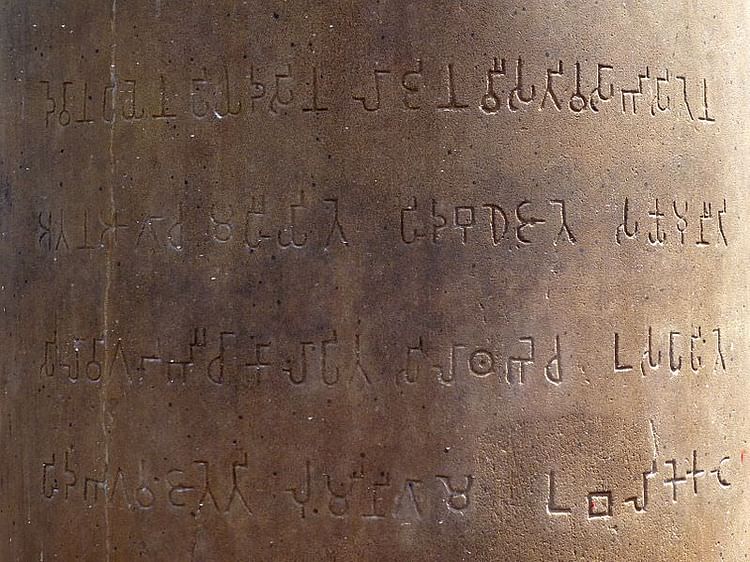
The Brahmi script is the earliest writing system developed in India after the Indus script. It is one of the most influential writing systems; all modern Indian scripts and several hundred scripts found in Southeast and East Asia are derived from Brahmi.
Rather than representing individual consonant (C) and vowel (V) sounds, its basic writing units represent syllables of various kinds (eg CV, CCV, CCCV, CVC, VC). Scripts which operate on this basis are normally classified as syllabic, but because the V and C component of Brahmi symbols are clearly distinguishable, it is classified as an alpha-syllabic writing system.
ORIGIN OF THE BRAHMI SCRIPT
One question about the origin of the Brahmi script relates to whether this system derived from another script or it was an indigenous invention. In the late 19th century, Georg Bühler advanced the idea that Brahmi was derived from the Semitic script and adapted by the Brahman scholars to suit the phonetic of Sanskrit and Prakrit. India became exposed to Semitic writing during the 6th century BCE when the Achaemenid empire took control of the Indus Valley (part of present-day Afghanistan, Pakistan, and northwestern India). Aramaic was the language of administration in the Achaemenid empire, and official records were written using a North Semitic script.

Greek and Aramaic inscriptions by king Ashoka
Around this time, another script also developed in the region, known as Kharosthi, which remained dominant in the Indus Valley region, while the Brahmi script was employed in the rest of India and other parts of South Asia. Although we are confident that Kharosthi is an adaptation of Semitic, the connection between Brahmi and Semitic remains unclear.
BY THE 2ND CENTURY BCE, THE BRAHMI SCRIPT BECOMES MORE WIDESPREAD & WE CAN ALSO DETECT THE RISE OF MARKED REGIONAL VARIATIONS.
Another position has been advanced by professor K. Rajan, who has argued that the precursor of the Brahmi script is a system of symbols found on graffiti marks located on several sites in Tamil-Nadu (South India). In this region, hundreds of graffiti either inscribed or carved on potsherds and rock have been found: some of these symbols are found at the end of Brahmi inscriptions. Dilip Chakrabarti supports the connection between graffiti marks and Brahmi based on evidence found at Vallam (South India), where the stratigraphic sequence has shown that only graffiti inscriptions were present in the lower levels, followed by a mix of graffiti and Brahmi script in the middle phases, followed by only Brahmi inscriptions in the latest strata. A similar picture has been produced by excavations at Mangudi, where only graffiti is found on early contexts, followed by examples of Brahmi script in the upper levels. Whether Brahmi truly derives from graffiti is hard to confirm but the connection between the two systems cannot be ruled out.
There is a third position that claims that Brahmi derives from the Indus script, a writing system employed in the Indus Civilization which fell out of use as this civilization came to an end. Those who support this hypothesis point out the resemblance between some of the signs of these scripts. Given the complete absence of material evidence linking both writing systems, this view seems both speculative and hard to verify.
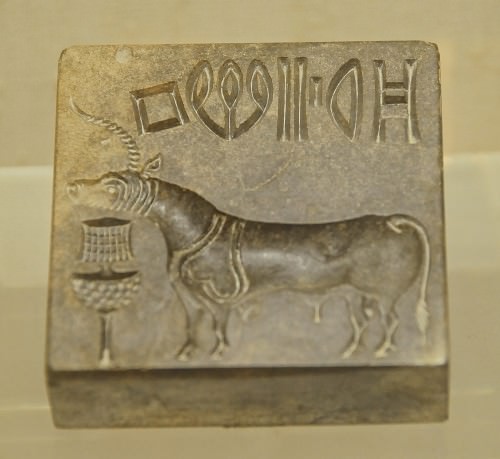
Unicorn Seal
Another question about the origin of the Brahmi script relates to its antiquity. Until a few decades ago, the earliest securely dated examples available of the Brahmi script dated back to the 3rd century BCE, during the time when India was ruled by the Mauryan dynasty. These examples were found on a set of royal rock inscriptions spread in North and Central India by the Indian emperor Ashoka (r. 268 BCE to 232 BCE), known as the Edicts of Ashoka or Ashokan Inscriptions.
Despite the lack of any earlier examples, some scholars argued that the Brahmi script had originated earlier than the 3rd century BCE. They supported such a claim on the basis of a number of observations. Firstly, the composition of a set of texts, the Brahmanas, which were attached to the Vedic literature during the 6th century BC. The Brahmanas are the only section of the Vedic corpus written mostly in prose, unlike the earlier sections of the Vedas which are hymns for recitation, specially design for oral transmission. The emergence of prose is hard to imagine without the support of writing technology. Further evidence comes from the work of Panini, the renown ancient Indian grammarian who composed an influential work on grammar analysis of Sanskrit during the 5th or 4th century BCE. It is unlikely that a work like this could have been produced in a preliterate context. Knowledge of writing in India is also recorded by writers who joined Alexander to India roughly a century before the time of Ashoka.

Ashokan Pillar Base, Sarnath
During the late 20th century CE, the notion that Brahmi originated before the 3rd century BCE gained strength when archaeologists working at Anuradhapura in Sri Lanka retrieved Brahmi inscriptions on pottery belonging to the 450-350 BCE period. The earliest of these examples are single letters, and their dates have been established through radiocarbon dating.The language of these inscriptions is North Indian Prakrit (Middle Indic), an Indo- Aryan language.
DEVELOPMENT OF THE BRAHMI SCRIPT
Most examples of Brahmi found in North and Central India represent Prakrit language. The Ashokan Inscriptions already show some slight regional variations on the Brahmi script. In South India, particularly in Tamil-Nadu, Brahmi inscriptions represent Tamil, a language belonging to the Dravidian language family, with no linguistic affiliation to the Indo-Aryan languages such as Sanskrit or Prakrit.
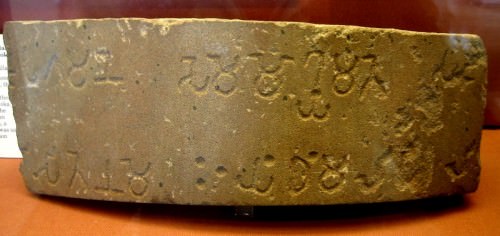
Pillar of Ashoka Fragment
Some Tamil examples come from inscribed potsherds found at Uraiyur (South India) dating to the 1st century BCE or the 1st century CE. In Arikamedu (South India) there is also evidence of an early form of Tamil in Brahmi inscriptions, dated to the early centuries CE. At this stage, different Brahmi characters specially adapted to suit Tamil phonetic were already in use.Examples of Tamil have not been identified among the earliest securely dated examples of Brahmi found at Anuradhapura in Sri Lanka, where the language represented is Prakrit.
By the 2nd century BCE, the Brahmi script becomes more widespread, and we can also detect the rise of marked regional variations.
MATERIAL FORM & USE
Ashokan inscriptions are found on carved rocks, caves, stones slabs, and rock pillars. We also have some examples of short Brahmi inscriptions on small seals made of ivory, bone, stone, and terracotta dated to Mauryan times. Other examples come from potsherds and copper plates. With the rise of Buddhism as the dominant faith in India, we find Brahmi inscriptions on monumental constructions known as 'donative records,' stating the names of different donors. The early 2nd century BCE saw the beginning of Brahmi inscriptions on coins.
The use of perishable materials as a writing medium is an ancient widespread practice in South Asia, particularly palm leaf and birch bark. As portable and affordable writing surfaces, these materials are ideal. Direct material evidence on the use of palm leaf and birch before the time of the Ashokan Inscriptions have not been found. This lack of direct evidence could have more to do with the bias of the archaeological record due to the destruction of evidence over time rather than the actual absence of a written tradition on perishable materials. Indirect evidence of the possible use of perishable writing surfaces has been retrieved at Sringaverapura in North India in the form of traces of birch wood, from levels dated to c. 10th to 7th century BCE period. D. Chakrabarti also mentions the presence of bone items described as possible stylus employed for writing on palm leaves and birch bark, but these objects could also have been arrows.
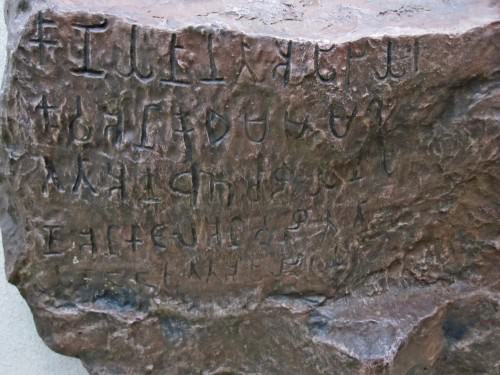
Mangulam inscription
The earliest identifiable use of Brahmi script found on ceramic surfaces was to indicate ownership of the item. Towards the mid-3rd century BCE, we see the first example of Brahmi being used for official communication in the production of seals and on the Ashokan Inscriptions. A few centuries later, Brahmi begins to be employed in religious contexts, both in architecture and for the transmission of religious texts.
If we accept the view that the use of Brahmi predates the earliest archaeological examples identified so far, then we could speculate that the earliest use of Brahmi was for the recording of commercial transactions and other forms or record-keeping.This is based on the fact that all over the world there is a tendency for writing systems to rise when the need of recording information becomes essential as a result of the rise of urbanism, social complexity, taxation, and increasing reliance on redistribution systems to support the growing demographic pressure. In North India, this process was well underway by the 7th century BCE. It would be unlikely that North India was able to develop and sustain such a level of social and economic transformation, including the rise of cities and kingdoms, in the absence of writing. If the work of Panini was produced with the aid of the Brahmi script, we could add that at some point during the 5th to 4th century BCE the system was refined and improved by the North Indian grammarians.
SCRIPTS DERIVED FROM BRAHMI
During its long history of development, there has been a large number of scripts derived from Brahmi. Many of the scripts derived from Brahmi have been adapted to suit the phonetic of several different languages, deriving in many script variations.The origin of numerous writing systems currently in use across Asia including the Gurmukhi, Kanarese, Sinhalese, Telugu, Thai, Tibetan, Javanese, and several others can be traced back to the Brahmi script.
Ashoka the Great › Who Was
Definition and Origins
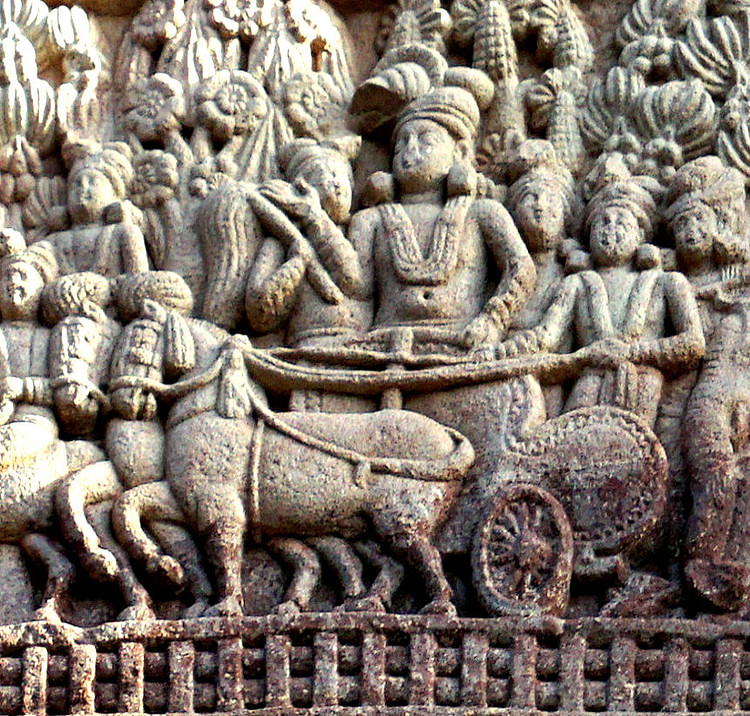
Emperor Ashoka the Great (sometimes spelt Aśoka) lived from 304 to 232 BCE and was the third ruler of the Indian Mauryan Empire, the largest ever in the Indian subcontinent and one of the world's largest empires at its time. He ruled form 268 BCE to 232 BCE and became a model of kingship in the Buddhist tradition. Under Ashoka India had an estimated population of 30 million, much higher than any of the contemporary Hellenistic kingdoms. After Ashoka's death, however, the Mauryan dynasty came to an end and its empire dissolved.
ASHOKA'S RULE
In the beginning, Ashoka ruled the empire like his grandfather did, in an efficient but cruel way. He used military strength in order to expand the empire and created sadistic rules against criminals. A Chinese traveller named Xuanzang (Hsüan-tsang) who visited India for several years during the 7th century CE, reports that even during his time, about 900 years after the time of Ashoka, Hindu tradition still remembered the prison Ashoka had established in the north of the capital as “Ashoka's hell”.Ashoka ordered that prisoners should be subject to all imagined and unimagined tortures and nobody should ever leave the prison alive.
During the expansion of the Mauryan Empire, Ashoka led a war against a feudal state named Kalinga (present day Orissa) with the goal of annexing its territory, something that his grandfather had already attempted to do. The conflict took place around 261 BCE and it is considered one of the most brutal and bloodiest wars in world history. The people from Kalinga defended themselves stubbornly, keeping their honour but losing the war: Ashoka's military strength was far beyond Kalinga's.The disaster in Kalinga was supreme: with around 300,000 casualties, the city devastated and thousands of surviving men, women and children deported.
AFTER THE WAR OF KALINGA, ASHOKA CONTROLLED ALL THE INDIAN SUBCONTINENT EXCEPT FOR THE EXTREME SOUTHERN PART.
What happened after this war has been subject to numerous stories and it is not easy to make a sharp distinction between facts and fiction. What is actually supported by historical evidence is that Ashoka issued an edict expressing his regret for the suffering inflicted in Kalinga and assuring that he would renounce war and embrace the propagation of dharma. What Ashoka meant by dharma is not entirely clear: some believe that he was referring to the teachings of the Buddha and, therefore, he was expressing his conversion to Buddhism. But the word dharma, in the context of Ashoka, had also other meanings not necessarily linked to Buddhism. It is true, however, that in subsequent inscriptions Ashoka specifically mentions Buddhist sites and Buddhist texts, but what he meant by the word dharma seems to be more related to morals, social concerns and religious tolerance rather than Buddhism.
THE EDICTS OF ASHOKA
After the war of Kalinga, Ashoka controlled all the Indian subcontinent except for the extreme southern part and he could have easily controlled that remaining part as well, but he decided not to. Some versions say that Ashoka was sickened by the slaughter of the war and refused to keep on fighting. Whatever his reasons were, Ashoka stopped his expansion policy and India turned into a prosperous and peaceful place for the years to come.

Greek and Aramaic inscriptions by king Ashoka
Ashoka began to issue one of the most famous edicts in the history of government and instructed his officials to carve them on rocks and pillars, in line with the local dialects and in a very simple fashion. In the rock edicts, Ashoka talks about religious freedom and religious tolerance, he instructs his officials to help the poor and the elderly, establishes medical facilities for humans and animals, commands obedience to parents, respect for elders, generosity for all priests and ascetic orders no matter their creed, orders fruit and shade trees to be planted and also wells to be dug along the roads so travellers can benefit from them.
However attractive all this edicts might seem, the reality is that some sectors of Indian society were truly upset about them.Brahman priests saw in them a serious limitation to their ancient ceremonies involving animal sacrifices, since the taking of animal life was no longer an easy business and hunters along with fishermen were equally angry about this. Peasants were also affected by this and were upset when officials told them that “chaff must not be set on fire along with the living things in it”.Brutal or peaceful, it seems that no ruler can fully satisfy the people.
SUPPORT FOR BUDDHISM
The Buddhist tradition holds many legends about Ashoka. Some of these include stories about his conversion to Buddhism, his support of the monastic Buddhist communities, his decision to establish many Buddhist pilgrimage sites, his worship of the bodhi tree under which the Buddha attained enlightenment, his central role organizing the Third Buddhist Council, followed by the support of Buddhist missions all over the empire and even beyond as far as Greece, Egypt and Syria. The Buddhist Theravada tradition claims that a group of Buddhist missionaries sent by Emperor Ashoka introduced the Sthaviravada school (a Buddhist school no longer existent) in Sri Lanka, about 240 BCE.
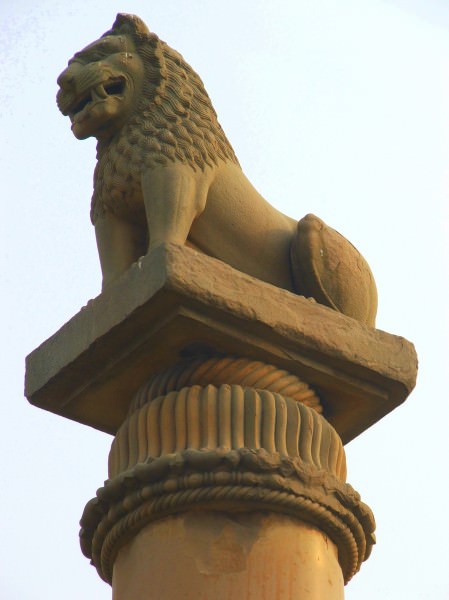
Ashoka's pillar
It is not possible to know which of these claims are actual historical facts. What we do know is that Ashoka turned Buddhism into a state religion and encouraged Buddhist missionary activity. He also provided a favourable climate for the acceptance of Buddhist ideas, and generated among Buddhist monks certain expectations of support and influence on the machinery of political decision making. Prior to Ashoka Buddhism was a relatively minor tradition in India and some scholars have proposed that the impact of the Buddha in his own day was relatively limited. Archaeological evidence for Buddhism between the death of the Buddha and the time of Ashoka is scarce; after the time of Ashoka it is abundant.
A PARTICULAR STORY TELLS THAT ASHOKA BUILT 84,000 STUPAS.
Was Ashoka a true follower of the Buddhist doctrine or was he simply using Buddhism as a way of reducing social conflict by favouring a tolerant system of thought and thus make it easier to rule over a nation composed of several states that were annexed through war? Was his conversion to Buddhism truly honest or did he see Buddhism as a useful psychological tool for social cohesion? The intentions of Ashoka remain unknown and there are all types of arguments supporting both views.
ASHOKA'S LEGACY
He did with Buddhism in India what Emperor Constantine did with Christianity in Europe and what the Han dynasty did with Confucianism in China : he turned a tradition into an official state ideology and thanks to his support Buddhism ceased to be a local Indian cult and began its long transformation into a world religion. Eventually, Buddhism died out in India sometime after Ashoka's death, but it remained popular outside its native land, especially in eastern and south-eastern Asia. The world owes to Ashoka the growth of one of the world's largest spiritual traditions.
LICENSE:
Article based on information obtained from these sources:with permission from the Website Ancient History Encyclopedia
Content is available under License Creative Commons: Attribution-NonCommercial-ShareAlike 3.0 Unported. CC-BY-NC-SA License